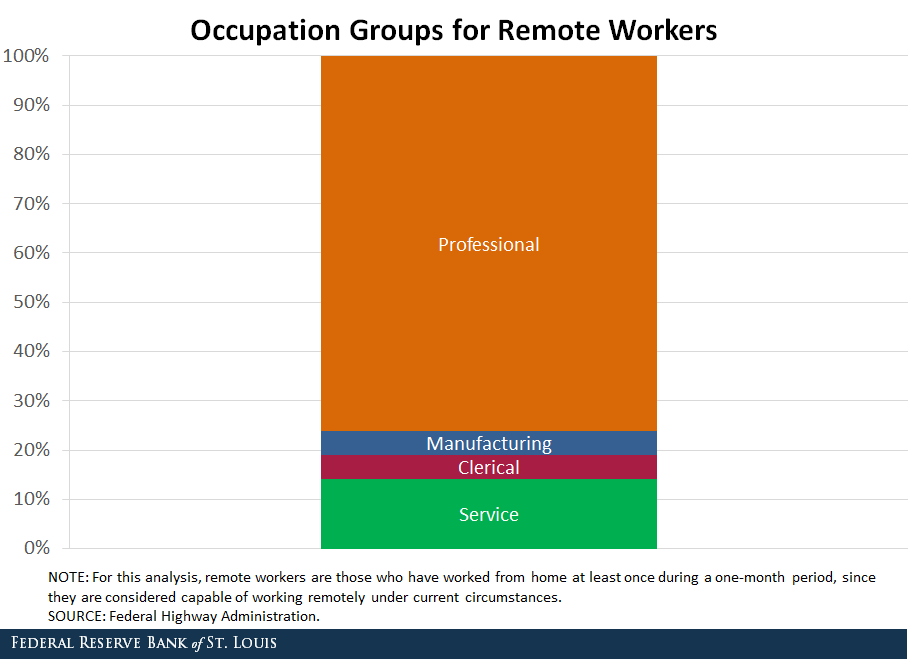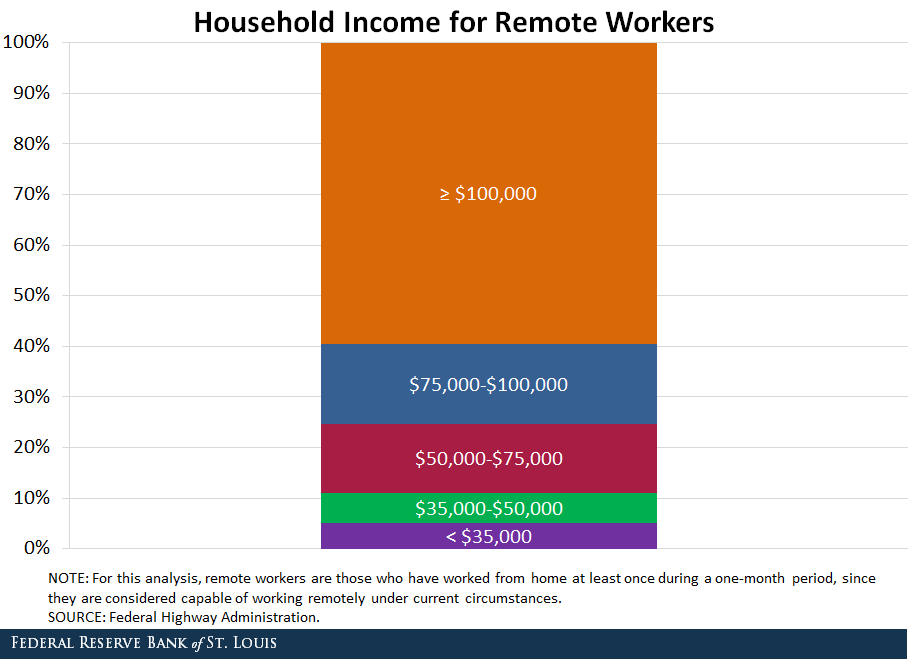How Many Employees Are Prepared to Work from Home?
Due to COVID-19, many firms are asking their employees to work remotely. There are also cases of firms halting work altogether, including automobile manufacturers halting production lines.
In response to the viral outbreak, many state governments have ordered public spaces—such as restaurants—to close or to limit occupancy. In occupations less prepared for remote work, we will expect to see more workers furloughed or laid off as a response to these public health measures. Below we discuss which types of workers are most likely to adjust to the current crisis by working from home based on occupation and income.
Who Can Telecommute?
An increasing trend toward telecommuting since 1980 has been documented in other research by the Federal Reserve Bank of St. Louis.Arbogast, Iris; Gascon, Charles S.; and Spewak, Andrew. “Working from Home: More Americans Are Telecommuting.” Regional Economist, Oct. 9, 2019. Here, we consider a broader definition of telework in the U.S.: workers who have worked from home at least once during a one-month period. We consider these workers as capable of working remotely under current circumstances. We estimate 13% of full-time workers are ready for remote work as of 2017.Using the Federal Highway Admiration’s National Household Travel Survey (NHTS) in 2017, we can determine the number of times respondents telecommuted in the survey month. The NHTS also provides income and occupational background of most respondents.
Remote Worker Occupations
The first figure decomposes remote-ready workers by occupation.

Professional workers (includes managerial and technical occupations) represent a little more than 75% of remote-ready workers. Service workers (includes sales) represent approximately 14%. Manufacturing (which also includes construction and farming) and clerical occupations each represent only 5% of remote-ready workers.
Remote Worker Incomes
The next figure decomposes the remote-ready workers by household income.

Individuals in household earning more than $100,000 per year comprise 60% of teleworkers. Those with incomes less than $50,000, together, are only 11% of remote-ready workers.
Effects on Workers
These figures suggest which workers are likely to be asked to work from home during the pandemic event and which are likely to be out of work (though some may remain on payroll). Those with higher household incomes in professional occupations are most likely to work remotely.
As businesses close their doors or send their workers home, the financial burden of the crisis will likely be felt hardest by lower-income individuals in nonprofessional occupations. Policies to deal with this burden will need to address the loss of income for these individuals while respecting the precautions needed to deal the outbreak.
In a recent Economic Synopses, Bill Dupor discussed possible federal stimulus policies in times of viral outbreak to help furloughed or laid-off workers, which would assist those we’ve identified as less capable of remote work.Dupor, Bill. “Possible Fiscal Policies for Rare, Unanticipated, and Severe Viral Outbreaks.” Economic Synopses, March 17, 2020.
Notes and References
1 Arbogast, Iris; Gascon, Charles S.; and Spewak, Andrew. “Working from Home: More Americans Are Telecommuting.” Regional Economist, Oct. 9, 2019.
2 Using the Federal Highway Admiration’s National Household Travel Survey (NHTS) in 2017, we can determine the number of times respondents telecommuted in the survey month. The NHTS also provides income and occupational background of most respondents.
3 Dupor, Bill. “Possible Fiscal Policies for Rare, Unanticipated, and Severe Viral Outbreaks.” Economic Synopses, March 17, 2020.
Additional Resources
Citation
Charles S. Gascon and Mahdi Ebsim, ldquoHow Many Employees Are Prepared to Work from Home?,rdquo St. Louis Fed On the Economy, March 23, 2020.
This blog offers commentary, analysis and data from our economists and experts. Views expressed are not necessarily those of the St. Louis Fed or Federal Reserve System.
Email Us
All other blog-related questions



